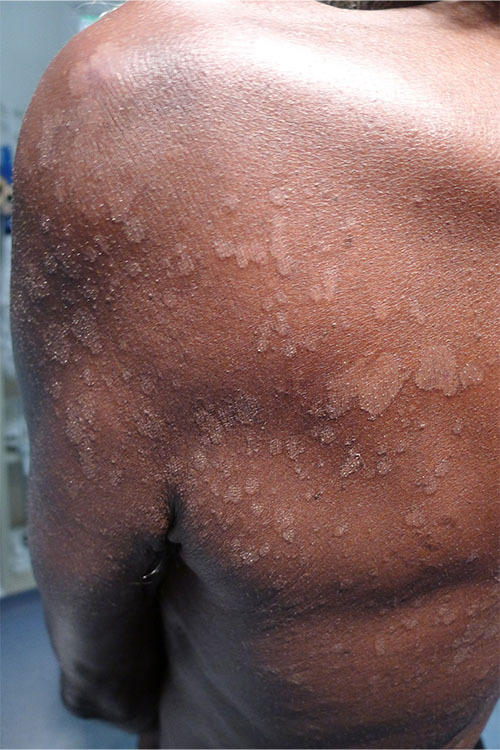Pityriasis versicolor
Pityriasis versicolor is a common chronic condition caused by Malassezia yeasts, which are normal skin commensal organisms. Pityriasis alba and pityriasis rosea are unrelated skin conditions.
Pityriasis versicolor presents with patches of hyperpigmentation or hypopigmentation. Well-demarcated pale or tan macules with fine scale are usually limited to the upper trunk; however, sometimes the whole trunk, upper arms and neck (but not face) are affected. The macules can coalesce. The fine scale of lesions can become more apparent when the affected skin is stretched or scraped (ie the ‘evoked scale sign’)Renati, 2015. The rash is commonly asymptomatic, but may be slightly itchy. For photos of pityriasis versicolor, see here.
Pityriasis versicolor is mainly seen in young adults, and is rarely seen before puberty. The condition is common in tropical climates, and is exacerbated by heavy sweating.
Diagnosis is usually clinical.
General measures (eg showering after excessive sweating) can help. Treat hyperhidrosis if present.
If treatment for pityriasis versicolor is sought, it is usually for cosmetic reasons. Use:
1econazole 1% solution topically, once daily at night to wet skin (leave overnight and wash off the following morning), for 3 nights econazole econazole econazole
OR
1ketoconazole 2% shampoo topically, once daily (leave for 3 to 5 minutes and wash off), for 5 days ketoconazole ketoconazole ketoconazole
OR
1selenium sulfide 2.5% shampoo topically, once daily to wet skin (leave for at least 10 minutes or overnight, and wash off), for 7 to 10 days. selenium sulfide selenium selenium
If the condition is localised to a small area, an imidazole cream or lotion can be used for 10 days.
If pityriasis versicolor does not respond, use oral therapy. Use:
fluconazole 400 mg orally, as a single dose. fluconazole fluconazole fluconazole
Do not use griseofulvin or terbinafine because they are ineffective against Malassezia yeasts.
In some patients with dark skin types, pityriasis versicolor causes hypopigmentation. This can persist for several months after mycological cure. To differentiate between persistent hypopigmentation after cure and treatment failure or recurrence, consider scraping for microscopy.
Pityriasis versicolor often recurs. Repeated courses of treatment may be needed. For maintenance therapy, one of the above shampoos can be used; shampoos can be used once to twice weekly, or more or less frequently depending on patient response and severity.
If pityriasis versicolor does not respond to treatment, or is frequently recurring, refer to a dermatologist for consideration of oral treatments (eg itraconazole, isotretinoin).


